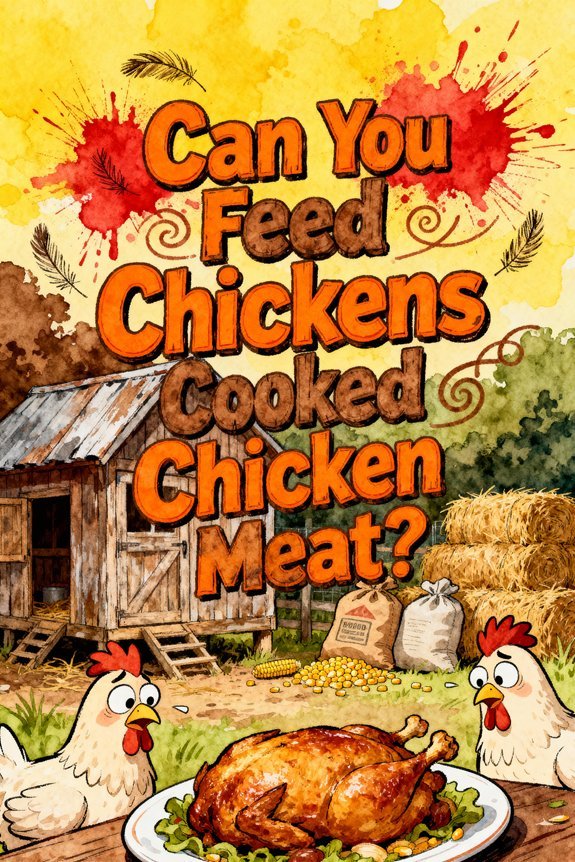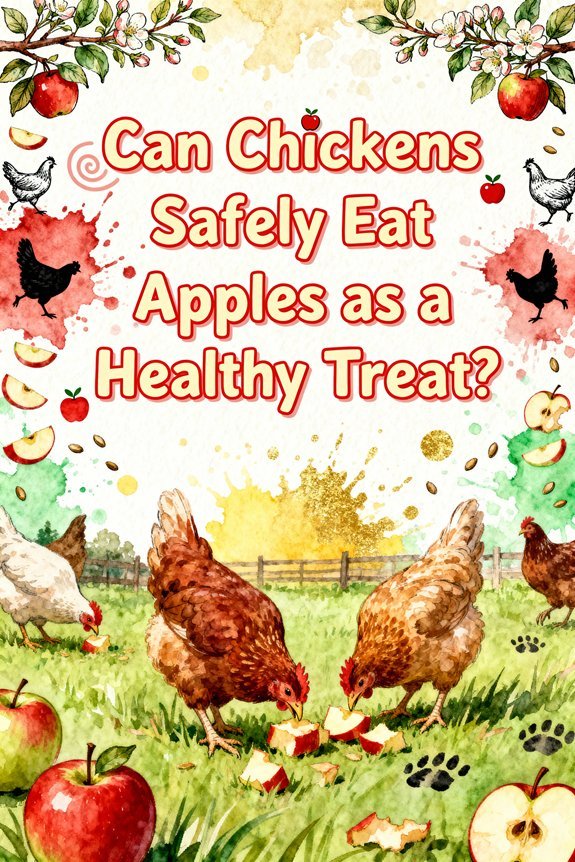Can You Feed Chickens Cooked Chicken Meat?
You can feed your chickens cooked chicken meat as a nutritious protein supplement, providing 27-31g of protein per 100g along with essential B vitamins and minerals. Cook the meat thoroughly to 165°F (74°C) to eliminate pathogens, and limit portions to 10% of their daily diet. Remove bones to prevent injury, avoid seasonings, and serve in small pieces during active hours. Proper handling and portion control techniques will maximize the benefits while ensuring your flock’s safety.
The Safety Benefits of Feeding Cooked vs. Raw Chicken
Although both cooked and raw chicken meat can provide protein for chickens, feeding cooked chicken offers significant safety advantages. Cooking thoroughly eliminates harmful bacteria like salmonella and destroys potential pathogens that could spread diseases throughout your flock. The cooked safety profile extends to preventing prion disease transmission, similar to historical cases of “mad cow disease” from raw meat feeding. Chickens naturally thrive on a diet that includes high-quality protein sources.
You’ll minimize cross-contamination risks by using separate utensils when preparing cooked chicken for your flock. While raw risks include exposure to dangerous bacteria and parasites, cooking transforms the meat’s texture and scent, reducing attraction to raw meat that might encourage cannibalistic behaviors. The protein quality remains equivalent between cooked and raw forms, ensuring your chickens receive proper nutrition without compromising their health through pathogen exposure.
Understanding the Nutritional Value for Your Flock
While safety considerations guide the decision to feed cooked chicken, understanding its nutritional composition helps optimize your flock’s diet. The nutrient breakdown reveals that cooked chicken provides 27-31g of protein per 100g, delivering complete amino acid profiles essential for muscle development, feather growth, and tissue repair. You’ll find 3.57-9.73g of total fat per 100g, supporting energy needs and vitamin absorption.
The meat’s micronutrient content includes crucial B vitamins, minerals like iron and zinc, plus calcium and phosphorus for bone health. Chickens can benefit from the high-quality protein content found in cooked chicken, which provides all nine essential amino acids. When you’re supplementing your chickens’ feed, cooked chicken can enhance the nutritional quality of plant-based proteins. However, you’ll need to monitor total protein intake, as excess can strain your birds’ kidneys, particularly in broilers requiring 15-23% dietary protein during growth stages.
Proper Portions and Serving Guidelines
When feeding cooked chicken meat to your flock, precise portioning and structured serving guidelines are essential for maintaining ideal health. You’ll need to limit cooked chicken to 10% of their daily diet and serve it in small, uniform pieces that they can consume in one feeding session. Monitor portion sizes based on your flock’s size and individual birds’ ages.
Establish a consistent feeding frequency by offering cooked chicken as an occasional treat during morning or early afternoon hours when birds are most active. Place the meat near the run’s perimeter using shallow dishes to prevent competition, and remove any uneaten portions within a few hours. During winter months when insect protein is scarce, cooked chicken can provide a valuable supplemental protein source. You’ll want to guarantee the meat is thoroughly cooked to 165°F and free from seasonings, bones, or additives that could harm your chickens. Your chickens can safely consume both the meat and chicken skin portions, as these provide additional nutrients to their omnivorous diet.
Best Practices for Food Handling and Storage
Since food safety directly impacts both human and chicken health, implementing proper handling protocols for cooked chicken is essential. When preparing chicken as feed, you’ll need to maintain strict temperature control throughout the process. Cook all meat to 165°F (74°C) using a calibrated thermometer, and refrigerate leftovers within two hours of cooking.
For proper food storage, keep cooked chicken in airtight containers at or below 40°F (4°C). Don’t store it longer than 2-3 days before feeding or freezing. Always use separate cutting boards and utensils for raw and cooked meat to prevent cross-contamination. When handling raw chicken, wash your hands thoroughly with soap for at least 20 seconds and clean all surfaces immediately with hot, soapy water. Never reuse containers or utensils that held raw chicken without proper sanitization. Remember that color alone cannot reliably determine if chicken is fully cooked.
Addressing Common Health and Behavioral Concerns
Although feeding cooked chicken meat to chickens raises several health and behavioral considerations, proper management can minimize potential risks. When introducing cooked chicken to your flock’s diet, monitor their feeding preferences and behavioral adaptations closely. While chickens naturally consume meat through foraging, excessive amounts can lead to nutritional imbalances and potential health complications. You’ll need to watch for signs of adverse reactions, particularly if the meat contains seasonings or high salt content that could cause dehydration or heart issues. To maintain flock health, verify the meat is properly cooked to eliminate pathogens, avoid processed varieties with harmful additives, and serve in moderated portions. Remember that cooked meat should only supplement their primary grain and plant-based diet, not replace it. Since chickens are omnivorous creatures, they can safely consume meat as part of their varied nutritional intake.
Types of Chicken Meat to Offer Your Birds
Three primary types of cooked chicken meat are suitable for feeding to your backyard flock. First, lean breast meat, trimmed of excess fat, provides ideal protein without risking fatty liver hemorrhagic syndrome. Second, plain cooked thigh meat offers a balanced protein source when cut into small, manageable pieces. Third, deboned wing meat can serve as an occasional treat when properly sized to prevent choking hazards.
When preparing these chicken cuts, you’ll need to verify they’re thoroughly cooked without seasonings, salt, or additives. The meat types should be fresh, never processed, and cut into bite-sized portions your birds can easily consume. You’ll want to avoid breaded, fried, or seasoned varieties, as these can introduce harmful compounds to your flock’s diet. Always ensure meat is thoroughly cooked to eliminate any risk of salmonella or harmful bacteria.
What to Avoid When Feeding Meat to Chickens
While proper meat selection enhances your chickens’ nutrition, understanding what to avoid safeguards their health. In meat sourcing, you’ll need to avoid raw meat containing pathogens like Salmonella, E. coli, and Listeria. Don’t feed processed meats high in sodium and preservatives, as they can cause dehydration and digestive issues. Like sausage and bacon, fatty processed meats should be strictly limited or avoided altogether. Safe preparation requires eliminating fatty or fried meats that lead to obesity and reduced egg production. Balanced protein supplementation helps prevent nutritional deficiencies when offering meat scraps.
Never offer meat from diseased animals or unknown sources, as this risks introducing infections to your flock. You’ll also want to remove bones and cut meat into small pieces before feeding, as bone fragments can splinter and cause internal injuries. Cooking meat thoroughly helps prevent cannibalistic behavior in your flock. Proper storage and freshness remain critical for preventing foodborne illnesses in both chickens and handlers.
Tips for Successfully Adding Chicken to Their Diet
Successfully introducing chicken meat to your flock’s diet requires a systematic approach focused on preparation, timing, and portion control. Begin your meat introduction techniques by cutting cooked, lean chicken into small, manageable pieces and placing them near the run’s perimeter. You’ll want to start with minimal portions to monitor acceptance and prevent waste.
Enhance your feeding enrichment ideas by combining meat treats with hanging vegetable balls or other interactive elements. Make sure you’re offering the meat fresh and unseasoned, cooking it thoroughly to eliminate pathogens while maintaining its nutritional value. Raw meat is unsafe for chickens due to harmful bacteria and parasites. Time your feedings strategically, providing meat only in quantities they’ll consume in one sitting. Don’t place meat near nesting areas, and always remove uneaten portions promptly to maintain hygiene and deter predators.






